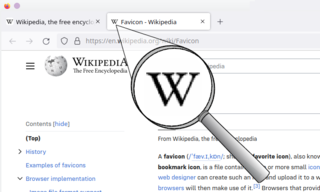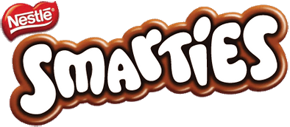
Geocaching is an outdoor recreational activity, in which participants use a Global Positioning System (GPS) receiver or mobile device and other navigational techniques to hide and seek containers, called geocaches or caches, at specific locations marked by coordinates all over the world. The first geocache was placed in 2000, and by 2023 there were over 3 million active caches worldwide.

The Tube map is a schematic transport map of the lines, stations and services of the London Underground, known colloquially as "the Tube", hence the map's name. The first schematic Tube map was designed by Harry Beck in 1931. Since then, it has been expanded to include more of London's public transport systems, including the Docklands Light Railway, London Overground, the Elizabeth line, Tramlink, the London Cable Car and Thameslink.

A favicon, also known as a shortcut icon, website icon, tab icon, URL icon, or bookmark icon, is a file containing one or more small icons associated with a particular website or web page. A web designer can create such an icon and upload it to a website by several means, and graphical web browsers will then make use of it. Browsers that provide favicon support typically display a page's favicon in the browser's address bar and next to the page's name in a list of bookmarks. Browsers that support a tabbed document interface typically show a page's favicon next to the page's title on the tab, and site-specific browsers use the favicon as a desktop icon.

Donatella Francesca Versace, sometimes simply referred to mononymously as Donatella, is an Italian fashion designer, Grand Ufficiale dell'Ordine al Merito della Repubblica Italiana and businesswoman, socialite, and model. She is the sister of Gianni Versace, founder of the luxury fashion company Versace, with whom she worked closely on the development of the brand and in particular its combining of Italian luxury with pop culture and celebrity.

Frank Shepard Fairey is an American contemporary artist, activist and founder of OBEY Clothing who emerged from the skateboarding scene. In 1989 he designed the "Andre the Giant Has a Posse" (...OBEY...) sticker campaign while attending the Rhode Island School of Design (RISD).

Smarties are color-varied, sugar-coated, dragée chocolate confectionery. They have been manufactured since 1937, originally by H.I. Rowntree & Company in the United Kingdom, and now by Nestlé.

Gianni Versace S.r.l., usually referred to as Versace, is an Italian luxury fashion company founded by Gianni Versace in 1978. The company produces Italian-made ready-to-wear and accessories, as well as haute couture under its Atelier Versace brand and licenses its name and branding to Luxottica for eyewear. Gianni Versace being a native of Calabria, in the ancient Magna Grecia, the company logo is inspired by Medusa, a figure from Greek mythology.

Google Maps is a web mapping platform and consumer application offered by Google. It offers satellite imagery, aerial photography, street maps, 360° interactive panoramic views of streets, real-time traffic conditions, and route planning for traveling by foot, car, bike, air and public transportation. As of 2020, Google Maps was being used by over one billion people every month around the world.
Andrew Reynolds is an American professional skateboarder known for co-founding Baker Skateboards in 2000 with artist Jay Strickland. He is now Baker Skateboard's sole owner. Reynolds established Bakerboys Distribution with Erik Ellington and Jim Greco in 2007. Bakerboys Distribution provides distribution for closely related in-house skateboard companies such as Deathwish Skateboards and Shake Junt. He is also the head of design at Altamont Apparel. Reynolds primarily skates street. He has been called one of the most influential skaters of all time.

Google Earth is a computer program that renders a 3D representation of Earth based primarily on satellite imagery. The program maps the Earth by superimposing satellite images, aerial photography, and GIS data onto a 3D globe, allowing users to see cities and landscapes from various angles. Users can explore the globe by entering addresses and coordinates, or by using a keyboard or mouse. The program can also be downloaded on a smartphone or tablet, using a touch screen or stylus to navigate. Users may use the program to add their own data using Keyhole Markup Language and upload them through various sources, such as forums or blogs. Google Earth is able to show various kinds of images overlaid on the surface of the Earth and is also a Web Map Service client. In 2019, Google revealed that Google Earth now covers more than 97 percent of the world, and has captured 10 million miles of Street View imagery.

Smarties Candy Company is a confectionery company well known for its namesake candy, Smarties. Edward "Eddie" Dee founded Ce De Candy in Bloomfield, New Jersey, in 1949. Dee emigrated from England to the United States.

Google Street View is a technology featured in Google Maps and Google Earth that provides interactive panoramas from positions along many streets in the world. It was launched in 2007 in several cities in the United States, and has since expanded to include all of the country's major and minor cities, as well as the cities and rural areas of many other countries worldwide. Streets with Street View imagery available are shown as clickable blue lines on Google Maps.

Aram Bartholl is a Berlin-based conceptual artist known for his examination of the relationship between the digital and physical world. His works often deal with anonymity and privacy. Aram Bartholl is currently Professor for art with digital media at HAW Hamburg.
Waze Mobile Ltd, doing business as Waze, formerly FreeMap Israel, is a subsidiary company of Google that provides satellite navigation software on smartphones and other computers that support the Global Positioning System (GPS). In addition to turn-by-turn navigation, it incorporates user-submitted travel times and route details while downloading location-dependent information over a cellular network. Waze describes its application as a community-driven initiative that is free to download and use.
The following is a timeline for Google Street View, a technology implemented in Google Maps and Google Earth that provides ground-level interactive panoramas of cities. The service was first introduced in the United States on May 25, 2007, and initially covered only five cities: San Francisco, Las Vegas, Denver, Miami, and New York City. By the end of 2008, Street View had full coverage available for all of the major and minor cities in the continental United States, and had started expanding its scope to include some of the country's national parks, as well as cities elsewhere in the world. For the first year and a half of its existence, Street View featured camera icon markers, each representing at least one major city or area. By its 10th anniversary, the Street View service had provided imagery for more than 10 million miles' worth of roads across 83 countries worldwide.
American entertainer Jennifer Lopez wore a green Versace silk chiffon dress to the 42nd Grammy Awards ceremony on February 23, 2000. The sheer fabric was printed with a tropical leaf and bamboo pattern, and cut with a very low neckline that extended well past Lopez's navel, while the waist of the dress was studded with citrines.

David Datuna was a Georgian-born American artist who lived in New York City. His Viewpoint of Millions series explores the sources and meaning of cultural identity from different points of view.

Kabalagala is a neighbourhood in Kampala, the capital and largest city in Uganda. It houses some of the leading partygoers in the city. It is located next to Nsambya where the American Embassy in Uganda is found.

Notes is a notetaking app developed by Apple Inc. It is provided on the company's iOS, iPadOS, visionOS, and macOS operating systems, the latter starting with OS X Mountain Lion. It functions as a service for making short text notes, which can be synchronized between devices using Apple's iCloud service. The application uses a similar interface on iOS and macOS, with a non-textured paper background for notes and light yellow icons, suggesting pencil or crayon. Until 2013, both applications used a strongly skeuomorphic interface, with a lined, textured paper design; the Mountain Lion version placed this inside a leather folder. This design was replaced in OS X Mavericks and iOS 7.

Jens Eilstrup Rasmussen is a Danish software engineer, technology executive, and co-founder of Where 2 Technologies which led to Google Maps.





















